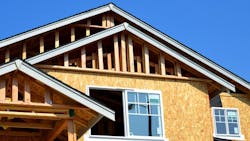Chairman's Message: NAHB’s Ideas for Federal Deregulation
This article first appeared in the July/August issue of Pro Builder.
Today, residential construction is one of the most heavily regulated industries in the country, and governmental overreach is directly fueling the national housing affordability crisis. Countless federal rules and regulations impact where and how new homes and apartments are built.
According to National Association of Home Builders (NAHB) research, regulations account for nearly 25% of the cost to build a single-family home and more than 40% for a multifamily development in terms of various fees, compliance, adjusting to building code changes, and time lost awaiting approvals and inspections during development and once construction begins.
It’s difficult to build affordable homes when the cost of regulations alone accounts for $93,870 of the price of an average new home. With surging housing costs and a nationwide shortage of approximately 1.5 million housing units, now is the time to remove unnecessary regulations to stimulate residential construction and benefit potential home buyers.
Recognizing the urgency, the Trump administration is keenly interested in deregulation. This spring, the Office of Management and Budget sought public opinion on potential deregulatory actions at the federal level.
In response, NAHB submitted more than 35 recommendations to reduce the regulatory burden in the housing industry and lower costs for home buyers.
Here are a few of NAHB’s ideas to ease unnecessary restrictions and reduce the cost burden facing the average American family.
National Flood Insurance Program Technical Bulletins
The National Flood Insurance Program (NFIP) requires buildings in 100-year flood zones to meet minimum standards set by the Federal Emergency Management Agency (FEMA), namely that buildings must be elevated above the base flood elevations on official maps.
But FEMA’s Technical Bulletins exceed these minimum standards by restricting ground-level use in multifamily buildings to parking, storage, or access only.
NAHB recommends removing this guidance and allowing lobbies and amenity spaces below base flood elevation if residential units are elevated. This would improve design, increase space efficiency and enable builders to deliver housing faster and more affordably.
Revised Definition of “Waters of the United States”
The definition of “waters of the United States” (WOTUS) under the Clean Water Act determines which bodies of water fall under federal environmental protection.
Recent changes have expanded the government's authority beyond Supreme Court rulings and created uncertainty and delays for developers, builders, and farmers seeking construction permits. This overreach increases housing costs and contributes to the national affordability crisis.
NAHB supports narrowing the definition to include only “relatively permanent” waters and excluding isolated wetlands, ponds, and ephemeral streams (those that flow only briefly during and following precipitation events, such as rainfall). This action would reduce compliance burdens, streamline permitting, and open more land for housing development.
RELATED:
- NAHB Chairman’s Message: Let Builders Build
- NAHB's Plan to Promote Housing Affordability
- Passions and Priorities for the Year
Heat Injury and Illness Prevention
The Occupational Safety and Health Administration (OSHA) has proposed a new rule targeting heat-related injury and illness prevention in indoor and outdoor work settings across many industries, including construction.
However, the one-size-fits-all proposal ignores the long-standing “water, rest, and shade” practice. It also would require formal prevention plans, extensive training, and detailed recordkeeping that many small home builders will struggle to manage.
NAHB recommends revising the to allow flexibility and recognize the unique needs of different industries and job sites in different climates, easing the burdens on small businesses that would delay projects and increase costs.
Davis-Bacon Act Reform
The Davis-Bacon Act sets wage rates for most publicly funded construction projects, including those supported by the U.S. Department of Housing and Urban Development (HUD) and Federal Housing Administration (FHA) multifamily programs.
The current wage determination process is outdated and flawed, often producing rates that don’t reflect actual local wages. Administrative burdens have also grown and made participation in Davis-Bacon projects financially infeasible for many builders.
NAHB supports withdrawing the current rule and reproposing it with substantial revisions to reduce costs, ease compliance, and support affordable housing development.
A key change is updating the wage-setting methodology to reflect accurate local wages and removing the split wage determination.
Looking Ahead
NAHB will continue to advocate for housing policies that enable builders to construct more attainable, affordable housing that the nation sorely needs. We will be working with the federal regulatory agencies as part of the Trump administration’s effort to identify common sense changes that will make regulations less burdensome.
At the same time, the association’s advocacy team will continue to work with our local and state associations to reduce local regulatory barriers to new home construction.
This is the strength of NAHB—a deep and experienced advocacy staff combined with the power of the association’s grassroots membership. At the local, state, and federal levels, we’ll work with anyone who can help us meet the housing needs of our nation’s families.
W2W4
Professional Women in Building (PWB) is the voice of women in the building industry — dedicated to promoting industry professionalism and supporting members at the local, state and national levels. Through education, professional development and networking opportunities, PWB helps members acquire and develop leadership and business management skills that boost career success. This Sept. 15-19, 2025, NAHB will celebrate women in our industry during Professional Women in Building Week. Visit nahb.org/pwbweek to help raise awareness of the opportunities for women in the home building industry.
Applications for NAHB’s Awards are now open. The NAHB Awards Program highlights the best and brightest in the residential construction industry in a variety of categories, including: The Best in American Living™ Awards, sponsored by SMEG; the Associates of Excellence Awards; the Custom Home Builder of the Year Award; the Leading Suppliers Council Spark Award; the Professional Women in Building (PWB) Awards; the NAHB/Builders Mutual Safety Award for Excellence (SAFE) Awards; the Nationals℠ Awards, NAHB’s largest awards competition; the NAHB Student Chapter Awards; and the Young Professional Awards. The deadline for entries for this year’s awards cycle is Oct. 6. Learn more at nahb.org/awards.
About the Author

Buddy Hughes
Buddy Hughes is the National Associaation of Home Builders' 2025 Chairman of the Board of Directors. A Lexington, N.C.-based, third-generation home builder and developer with more than 45 years of experience in the home building industry, he opened Hughes Construction in 1985 as a general contracting business that specializes in home building and light commercial construction. He currently serves as a life delegate of the NAHB Leadership Council and has been a member of the NAHB Board of Directors for more than 20 years.

